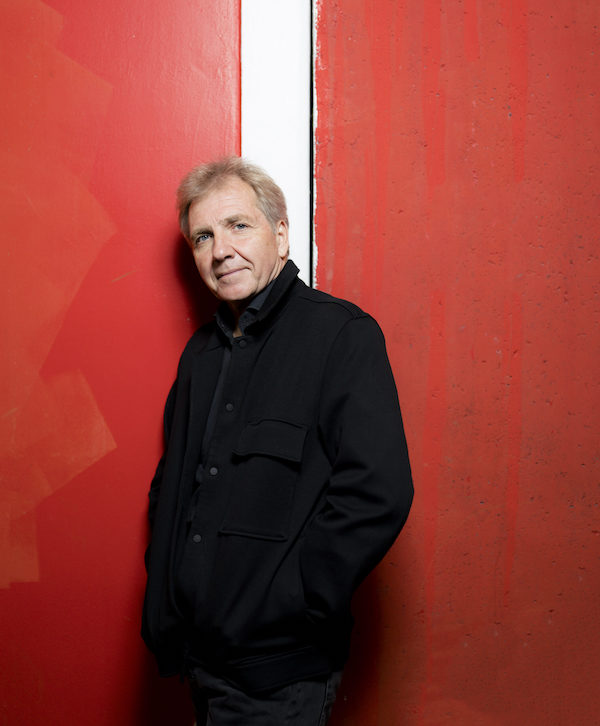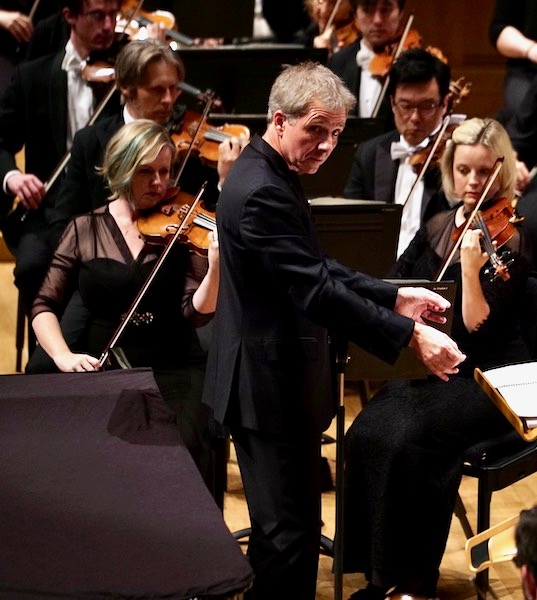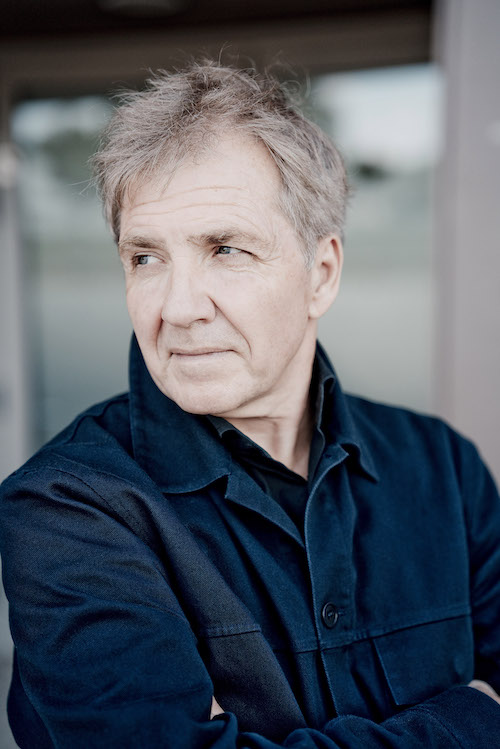A departing Thierry Fischer says his 14-year Utah Symphony tenure has been an organic partnership

Conductor Thierry Fisher was in a relaxed mood after conducting the Utah Symphony’s first rehearsal of Oliver Messiaen’s Turangalîla-Symphonie, a ten-movement, roughly 80-minute-long piece featuring over 100 musicians. That piece would comprise the entire program on Fischer’s penultimate concert as the orchestra’s music director.
Fischer assessed the task before him. “It’s the first rehearsal of a big piece nobody really knows,” he said. “As usual, the orchestra was very prepared, so I think we can put it together very quickly. Then, the challenge is the balance and working on different colors and layers.”
The orchestra demonstrated its flair for “colors and layers” this season, applying its transparent sound and varied palette of color to lushly orchestrated late Romantic and 20th century pieces, including those by Sibelius, Berg, Janáček, John Adams, and Bruckner.
The Swiss conductor concludes his 14-year tenure as music director this weekend, leading two performances of Mahler’s longest work, the Symphony No. 3.
For Fischer, the orchestra’s unique sonority is one of the joys of his final years as its music director. “I’m incredibility happy to hear how the orchestra developed in a very organic way over the years to have this very special sound they are having now,” he said. “It’s not just my sound or their sound, it’s our sound, which we developed together.”
Three of Fischer’s four final programs as music director feature a single vast work. Fischer said he is gratified by the orchestra’s ability to tackle monumental pieces. The Turangalîla comes close on the heels of the Utah Symphony premiere of Bruckner’s Symphony No. 5 (clocking in at around 75 minutes), which comprised the orchestra’s March 25 concert. This week, the orchestra plays Mahler’s Symphony 3 (100 minutes) for Fischer’s farewell concerts.
“When we touch such big pieces of art, it’s so immense that we don’t need anything else [on the program]” Fischer said. “For me, in my last weeks, it’s also a symbolic way of honoring the orchestra. They can do it. I sweat a lot to get the orchestra where it is now . . . You know, we worked for 14 years together. Now, let’s show who we are!”
Personnel-wise, the orchestra has changed dramatically since Fischer took the helm in 2009. He has appointed 42 of the current 87 musicians on the roster. Thirty of those were during Fischer’s first three years, when many long-time orchestra-members retired, including violinist Frances Darger, who had played in the orchestra for 69 years, since the age of 17.
The personnel changes have not been without controversy. In 2015, Fischer demoted concertmaster Ralph Matson, who was just shy of 30 years in the role, replacing him the following year with current concertmaster Madeline Adkins. (She won the role in a blind audition while serving as associate concertmaster of the Baltimore Symphony Orchestra.)
“Appointing new musicians is not a guarantee of success,” Fischer said. “A big challenge I tried to face with honesty, with artistic integrity, is how to make two generations of musicians play well together. When the transition started, there were some new people and some people who had been appointed by Maurice Abravanel.
“The difference of reactivity—the difference of give and take—was immense. It was experience versus intrepidity. In my choice of repertoire, in my choice of rehearsal technique it was always to challenge both generations with an equal desire of being better.”
Although she joined the orchestra after the major influx of new blood, Adkins also felt the challenge of mixing new and old. She likens it to cooking.
“If you’ve ever made an aioli at home, you know you have to add the oil very slowly to get it to emulsify, and if you add it too fast, then the ingredients don’t mix,” she said. “I kind of think of an orchestra like that, because if you add too many new things too fast, it’s not going to stay cohesive.
“You can lose the history, the style the orchestra played in, the institutional memory, the history of the ensemble, and the incredible wisdom so many of our players have—like how to play well in the hall,” she added.
She said the process of assimiliating younger players with orchestra veterans has, by necessity, taken many years. “It’s so great to have that fresh energy of twenty-somethings—which I’m definitely not— bringing this fresh energy and not losing what’s been so special about the symphony in the past.”
It was the orchestra’s past—and specifically the three-decade tenure of Maurice Abravanel (1947-1979)—that gave Fischer pause before accepting the board’s offer to become music director.
“I was hesitant to come, because I was not sure I could develop the organization the way the board wanted the organization to develop,” he recalled. “They had a clear vision in mind. Their vision was ‘We need the orchestra to be where Maurice Abravanel got the orchestra during his thirty-year tenure.’ My first contract was very short, because I wanted to be sure I could adapt to their needs.”
Upon beginning his tenure, Fischer made a multi-faceted effort to emulate Abravanel’s community outreach as well as his ambitious approach to touring and recording. The orchestra increased its educational concerts and did two statewide outdoor concert tours: the 2014 “Mighty 5” Tour to Utah’s five national parks and the 2017 “Great American Road Trip” to six Utah landmarks.
Fischer also increased the orchestra’s recording activity, beginning a new relationship with Hyperion records that included a three-volume cycle of Saint-Saëns’ complete symphonies, and a recently released recording of Messiaen’s Des Canyons aux etoiles, which the orchestra played last summer in Zion National Park. The orchestra also increased its output under its existing deal with Reference Recordings, recording works by Prokofiev, Mahler, Berlioz and an album of contemporary American composers.
In the 2015-2016 season the Utah Symphony celebrated its 75th anniversary, which Fischer described as a “turning point” in his efforts and in the orchestra’s integration into the community. The year was marked by collaborations with six different local arts organizations, including a new recording of Mahler’s Eighth Symphony with the Tabernacle Choir at Temple Square and a performance with the Utah Shakespeare festival pairing lines from Shakespeare’s Romeo and Juliet with Prokofiev’s music for the ballet of the same time. That season also marked the Utah Symphony’s return to Carnegie Hall, where its program included the New York premiere of Andrew Norman’s percussion concerto Switch, which the Utah Symphony commissioned.
“When you celebrate an anniversary, it’s not a glorious way of looking at what you’ve done, it’s a glorious party to share with all the partners in the same community,” Fischer said. “The anniversary was inviting everyone to join the party, and that was a turning point, because we could develop the idea that the Utah Symphony belongs to the community.”
As Fischer reflects on his time in Utah and prepares to devote more time to his role as music director of the São Paulo Symphony in Brazil—a role he officially assumed in March 2020—he looks back on his work with pleasure.
“There is no leadership without pleasure,” he said. “Leadership based on recipes and so-called golden rules works a very limited amount of time.”
Still, Fischer does recall one “golden rule” that guided his time in Utah. It originated in a book by Larry Miller, auto-dealership magnate and former Utah Jazz owner, which Miller’s widow Gail gifted to the conductor.
“I was very touched,” Fischer recalled. “Larry had a list of ten golden rules for leadership, because he was such an amazing, contagious leader in the community. I started to read these golden rules and the first one was: ‘Be There.’”
Fischer said “being there” became a guiding principle of his time in Utah. “That’s what a leader is: he’s there, he’s happy to be there, he’s facing contradiction, he’s facing huge challenges. And actually, you can do what you want, as you respect that you are there for them and not for you.”
Over the seven years of working with Fischer, what has stood out to concertmaster Adkins has been his joy in the music.
“There’s a lot of times when we’ll get to a really amazing part of a piece and he’ll look over at me and I’ll be smiling, and he’s smiling,” she said. “The ability to still find the beauty in a piece he’s done maybe two hundred times—I think that is a special quality of his.
“You know, that’s something you can’t fake.”
Thierry Fischer leads the Utah Symphony in Mahler’s Symphony No. 3, 7:30 p.m. Friday and Saturday. utahsymphony.org

